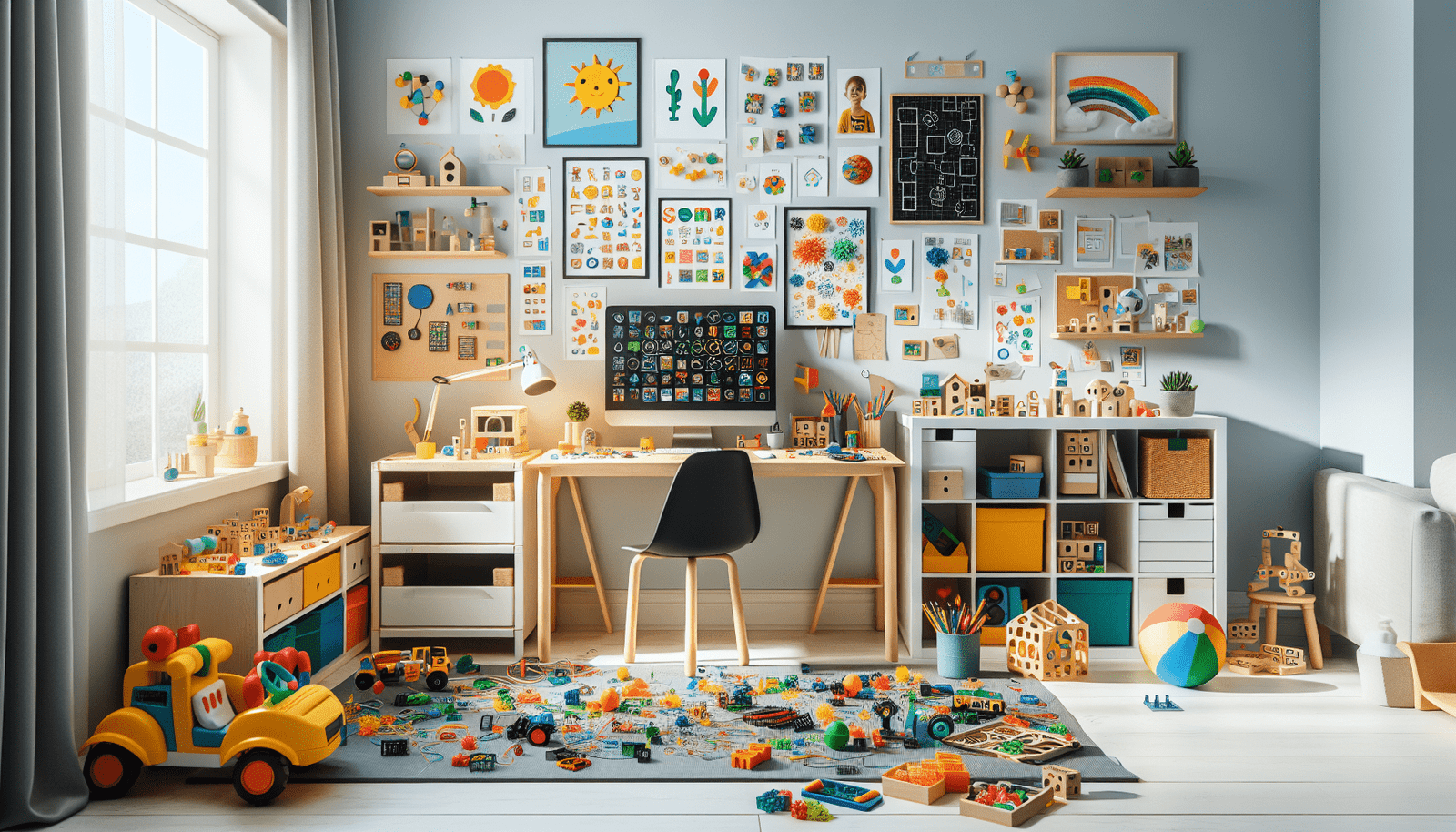Are you a parent or educator looking to create a fun and educational environment for your child at home? Look no further! In this article, we will explore the world of STEM (Science, Technology, Engineering, and Mathematics) toys and how you can easily incorporate them into your home to foster your child’s curiosity and love for learning. From the importance of STEM education to practical tips for setting up a STEM toy learning environment, we’ve got you covered. So, let’s dive in and discover how you can turn your home into a hub of educational fun!
How To Create A STEM Toy Learning Environment At Home
Understanding STEM Toys
Defining STEM Toys
STEM toys are educational toys that focus on Science, Technology, Engineering, and Mathematics (STEM) concepts. These toys are designed to engage children in hands-on learning experiences, encouraging them to explore and develop their problem-solving, critical thinking, and analytical skills.
Importance of STEM Toys
STEM toys are essential for a child’s development as they provide a foundation for future success in STEM-related fields. By engaging with STEM toys, children learn to think creatively, ask questions, and solve problems independently. These skills are vital in today’s technology-driven world and are highly sought-after by employers.
Benefits of STEM Learning
STEM learning offers numerous benefits to children. It helps develop their logical reasoning, improves cognitive abilities, and fosters a love for learning. Additionally, STEM learning encourages teamwork, communication, and perseverance, as children often work together to solve complex problems. By engaging in STEM activities, children also gain a better understanding of real-world applications of science and technology.
Selecting the Right STEM Toys
Age Appropriateness
When selecting STEM toys for your child, it is crucial to consider their age and developmental stage. Look for toys that are specifically designed for your child’s age group. Age-appropriate toys ensure that the content is challenging but not overwhelming, promoting successful learning experiences.
Skills Development Focus
Consider the specific skills you want your child to develop through STEM toys. Some toys may focus more on coding and programming skills, while others may emphasize hands-on experimentation or spatial reasoning. Choose toys that align with your child’s interests and areas for growth.
Interactivity and Engagement
Look for STEM toys that are interactive and engaging. Toys with features such as lights, sounds, and movement capture your child’s attention and make learning more fun. Interactive toys provide immediate feedback, which helps children understand the cause and effect relationship of their actions.
Safety and Quality
Prioritize safety and quality when choosing STEM toys. Look for toys that are made from non-toxic materials and have undergone rigorous safety testing. Check for any small parts or sharp edges that could pose a choking hazard. Additionally, choose toys from reputable brands known for their quality and durability.
Setting Up the STEM Learning Space
Choosing the Right Location
Find a designated space in your home where your child can engage in STEM learning activities. Ideally, this space should be well-lit, quiet, and free from distractions. It could be a corner of their bedroom, a playroom, or even a dedicated table in the living room.
Organizing the Space
Keep the STEM learning space well-organized and clutter-free. Have designated areas or containers for different types of STEM toys, ensuring easy access and storage. Consider using labeled bins or shelves to keep everything organized and encourage independent clean-up after playtime.
Creating a Conducive Environment
Make the STEM learning space inviting and inspiring for your child. Display their completed STEM projects, showcase relevant books or posters, and provide comfortable seating. Create a space that encourages curiosity, creativity, and a love for learning.
Incorporating Different Types of STEM Toys
Science Toys
Science toys focus on fostering a child’s understanding of the natural world, allowing them to explore concepts such as chemistry, biology, physics, and astronomy. These toys often involve experiments, observation, and exploration.
Technology Toys
Technology toys introduce children to concepts like coding, robotics, and electronics. These toys may include building kits, programmable robots, and coding games, providing hands-on experiences with technology.
Engineering Toys
Engineering toys focus on problem-solving, building, and construction. They encourage children to design and build structures, vehicles, and machines, stimulating creativity and logical thinking.
Mathematics Toys
Mathematics toys help children develop their numerical and problem-solving skills. They may involve puzzles, building blocks, or board games that require strategic thinking and logical reasoning.
Balancing Play and Learning
Making Learning Fun
Make STEM learning a fun and enjoyable experience for your child. Incorporate games, challenges, and rewards into their activities. Use positive reinforcement and praise their efforts and achievements to keep them motivated.
Ensuring Skill Development
While play is important, ensure that your child is also developing the necessary skills through their STEM activities. Choose toys that offer a progressive learning curve, allowing your child to gradually advance and build upon their skills.
Maintaining Child’s Interest
Pay attention to your child’s interests and adapt the STEM activities accordingly. If they show a particular interest in a certain topic or toy, explore it further and provide more challenging tasks within that area of interest. Keeping the activities relevant and engaging will sustain your child’s interest in STEM learning.
Guiding Your Child’s Interactions with STEM Toys
Encouraging Curiosity
Encourage your child to ask questions, explore, and experiment with their STEM toys. Foster their natural curiosity and be enthusiastic about their discoveries. Help them find answers to their questions and encourage them to find solutions independently.
Providing Guidance
While it is important to let your child explore and experiment, provide guidance when needed. Explain concepts, demonstrate techniques, and offer assistance when they face challenges. However, also encourage them to find their own solutions and learn from their mistakes.
Promoting Independent Learning
As your child becomes more comfortable with STEM toys, gradually encourage independent learning. Allow them to take the lead in designing and executing their projects. This promotes problem-solving skills, critical thinking, and independence.
Integrating STEM Toys into Daily Activities
Incorporating STEM Toys in Playtime
Integrate STEM toys into your child’s playtime routines. Encourage them to use their imagination and incorporate STEM concepts into their imaginative play. For example, building a space station with building blocks or creating a dinosaur-themed experiment with science kits.
Using STEM Toys in Homework
Support your child’s academic learning by incorporating STEM toys into their homework routine. For example, they can use geometry manipulatives to understand geometric concepts or use coding games to practice logical reasoning while developing their computer skills.
Making STEM Learning a Family Activity
Involve the entire family in STEM learning. Engage in collaborative projects, experiments, or puzzles together. This not only strengthens family bonds but also creates a supportive environment for learning and exploration.
Review and Evaluation of STEM Learning
Tracking Progress
Regularly assess your child’s progress in STEM learning. Keep track of their achievements, completed projects, and newfound skills. This allows you to identify areas of improvement and tailor future STEM activities accordingly.
Identifying Strengths and Weaknesses
Through observation and feedback from your child, identify their strengths and weaknesses in different STEM areas. Use this information to provide more opportunities for growth in their areas of strength and additional support in their areas of weakness.
Ensuring Consistent Learning
Consistency is key in STEM learning. Establish a regular schedule for your child to engage in STEM activities, ensuring that they have dedicated time to explore and learn. Consistent engagement helps reinforce concepts, build skills, and develop a deeper understanding of STEM concepts.
Ways to Keep STEM Learning Engaging Over Time
Rotating STEM Toys
To keep STEM learning exciting, regularly rotate the STEM toys available to your child. Introduce new toys or swap them with other children to foster variety and prevent boredom. This keeps the learning environment fresh and encourages continued engagement.
Introducing New Challenges
As your child progresses in their STEM learning journey, introduce new challenges and more advanced activities. This helps them expand their skill set, pushes their boundaries, and fosters growth and development.
Involving Peers in STEM Play
Encourage your child to engage in STEM learning with their peers. Arrange STEM playdates or join local STEM-focused clubs or communities. Peer interaction not only promotes teamwork and collaboration but also provides new perspectives and ideas.
Online Resources for STEM Learning at Home
Finding Quality Online Resources
When seeking online resources for STEM learning, ensure that they come from reputable sources. Look for websites, blogs, or video channels that offer age-appropriate and engaging content. Check for reviews and recommendations from other parents or educators.
Utilizing Online STEM Platforms
Consider utilizing online STEM platforms that offer interactive learning experiences. These platforms often have a wide range of educational games, activities, and lessons across various STEM subjects. Take advantage of these resources to supplement your child’s learning.
Joining STEM-focused Communities for Support
Join online communities or forums dedicated to STEM learning. These communities provide opportunities to connect with other parents, educators, and experts in the field. Share ideas, ask questions, and receive support and guidance to enhance your child’s STEM learning experience.
Creating a STEM toy learning environment at home is a fulfilling and rewarding experience for both you and your child. By understanding the importance of STEM toys, selecting the right ones, setting up a conducive learning space, and incorporating engaging activities, you can provide your child with a solid foundation in STEM subjects. Foster their curiosity, guide their interactions, and integrate STEM toys into various aspects of their daily lives to ensure consistent learning and growth. With the abundance of online resources available, you can also leverage technology to enhance their STEM learning journey. So, embrace the world of STEM toys and watch your child’s passion for learning flourish!
Interested in seeing the products we use?
Check out our carefully crafted list of items













